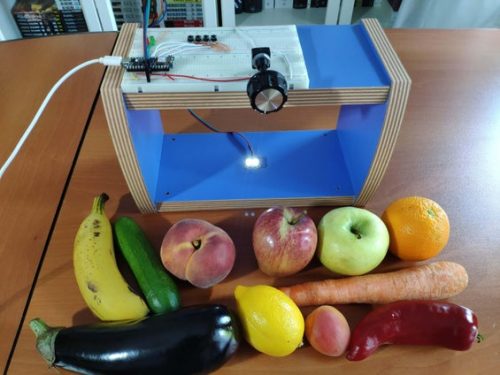- makeITcircular 2024 content launched – Part of Maker Faire Rome 2024Posted 2 weeks ago
- Application For Maker Faire Rome 2024: Deadline June 20thPosted 2 months ago
- Building a 3D Digital Clock with ArduinoPosted 7 months ago
- Creating a controller for Minecraft with realistic body movements using ArduinoPosted 7 months ago
- Snowflake with ArduinoPosted 8 months ago
- Holographic Christmas TreePosted 8 months ago
- Segstick: Build Your Own Self-Balancing Vehicle in Just 2 Days with ArduinoPosted 8 months ago
- ZSWatch: An Open-Source Smartwatch Project Based on the Zephyr Operating SystemPosted 9 months ago
- What is IoT and which devices to usePosted 9 months ago
- Maker Faire Rome Unveils Thrilling “Padel Smash Future” Pavilion for Sports EnthusiastsPosted 10 months ago
Check if the fruit is ripe with Arduino!
In this project we see how to build a device that detects maturation stages based on color with a neural network model. As fruits and vegetables ripen, they change color due to the four families of pigments: chlorophyll (green), carotenoids (yellow, red, orange), flavonoids (red, blue, purple), betalain (red, yellow, purple).
These pigments are groups of molecular structures that absorb a specific set of wavelengths and reflect the rest. Unripe fruits are green due to the chlorophyll in their cells. As they mature, the chlorophyll breaks down and is replaced by orange carotenoids and red anthocyanins. These compounds are antioxidants that prevent the fruit from spoiling too quickly in the air.

After doing some research on color change processes during fruit and vegetable ripening, we decided to build an artificial neural network (ANN) based on the classification model to interpret the color of fruit and vegetables and predict ripening stages.
Before building and testing the neural network model, we developed a web application in PHP (running on a Raspberry Pi 3B +) to collect the color data generated by the AS7341 visible light sensor and create a dataset on the maturation stages . We used an Arduino Nano 33 IoT to send the produced data to the web application.
After completing the dataset, we built the artificial neural network (ANN) with TensorFlow.
















One Comment